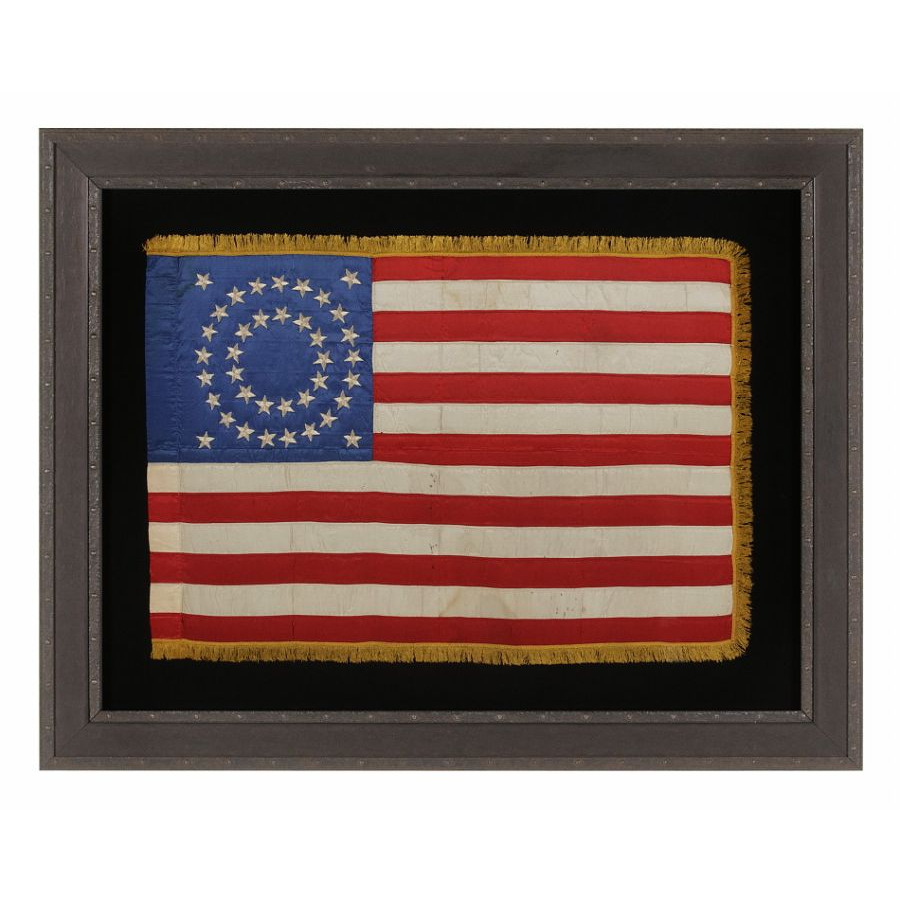
| |
RARE & BEAUTIFUL 38 STAR ANTIQUE AMERICAN FLAG, AN INDIAN WAR PERIOD MILITARY GUIDON, MADE OF SILK AND ENTIRELY HAND-SEWN, WITH EMBROIDERED STARS IN A MEDALLION CONFIGURATION, 1876-1889, COLORADO STATEHOOD |
|
| Available: |
Sold |
| Frame Size (H x L): |
30.5" x 38.75" |
| Flag Size (H x L): |
20" x 28.5" |
|
| Description....: |
|
Indian Wars period military guidons are especially rare in the private marketplace. I have seen fewer than 10 examples. Typically constructed of fine silk, like this example, these small flags were affixed to a wooden pole that fit down the barrel of a musket. A soldier would shoulder his rifle, thereby displaying the flag and marking the end of the flank. This helped in the formation of troops and as a visual aid for officers.
Construction of the stars on flank markers varied from one to the next. The 38 stars on this example are beautifully embroidered in silk floss and are configured in a circular medallion with a single star outside the pattern in each corner of the blue canton. Specifically this is known as a double wreath, having two concentric rings of stars. Since there was no official star pattern until 1912, the design was left up to the whims of either the flag-maker or the entity that ordered their manufacture.
Most ground force military flags were fringed on three sides like this flag, which is bordered by a variety made of fine yellow silk. The flag is expertly hand-sewn and hand-embroidered throughout. An open sleeve was created by rolling the hoist back onto itself, which was then lined on the interior with cotton. A small slit at the top and bottom of this probably accommodated space for cord to which tassels were attached.
Infantry flank markers are the smallest type of flag with sewn construction that was made with any regularity during this early period in American history. Because 19th century Stars & Stripes produced for military purpose are so rare in the private marketplace, because of this flag's elaborate silk construction and strikingly graphic presentation, and because the size is small enough to easily frame and display, this is an extraordinary addition to any collection.
Colorado became the 38th state on August 1st, 1876. This was the year of our nation’s 100-year anniversary of independence. Per the Third Flag Act of 1818, stars were not officially added until the 4th of July following a state's addition. For this reason, 37 was the official star count for the American flag in 1876. Flag-making was a competitive venture, however, and few flag-makers would have been continuing to produce 37 star flags when their competitors were making 38’s. It is for this reason that 38 and 13 stars (to represent the original 13 colonies) are more often seen at the Centennial International Exposition, the six-month long World’s Fair held in Philadelphia in honor of the event. Some flag-makers would have been adding a star for the 38th state even before it entered the Union, in the early part of 1876 or even prior. In fact, many makers of parade flags were actually producing 39 star flags, in hopeful anticipation of the addition of two more Western Territories instead of one. But the 39th state would not join the Union for another 13 years, when the Dakota Territory entered as two states on the same day. The 38 star flag became official on July 4th, 1877 and was generally used until the addition of the Dakotas in 1889.
President Ulysses S. Grant was in office when the first 38 star flags would have appeared. The list of presidents serving during the period when the 38 star flag was actually official include Rutherford B. Hayes, James Garfield, Chester Arthur, Grover Cleveland, and Benjamin Harrison.
Mounting: This is a pressure mount between 100% hemp fabric and U.V. protective acrylic. The 3-part frame is made of wood, yet has an excellent, distressed metallic finish that presents like gunmetal and rusted antique iron.
Condition: The overall condition is simply excellent among silk flags of this period. There is a lateral split in the center red stripe. Fabric of similar coloration was placed behind the flag for masking purposes. Most silk flags made during the latter half of the 19th century were made of fabric weighted with mineral salts. These were especially caustic and resulted in severe breakdown over time. While condition isn't everything in early flags, and many of my clients prefer flags to show their age and history of use, it is, however, especially nice to find an example like this one, in such an excellent state of preservation. |
|
|
|
| Collector Level: |
Flags for the truest Patriots. My best offerings |
|
| Flag Type: |
Sewn flag |
|
| Star Count: |
38 |
|
| Earliest Date of Origin: |
1876 |
|
| Latest Date of Origin: |
1889 |
|
| State/Affiliation: |
Colorado |
|
| War Association: |
1866-1890 Indian Wars |
|
| Price: |
SOLD |
|
| |
Views: 1443 |
|
|
|

